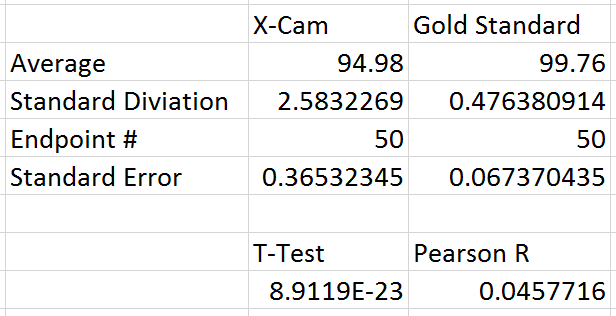BME100 s2015:Group16 12pmL3
| Home People Lab Write-Up 1 | Lab Write-Up 2 | Lab Write-Up 3 Lab Write-Up 4 | Lab Write-Up 5 | Lab Write-Up 6 Course Logistics For Instructors Photos Wiki Editing Help | ||||||
|
OUR TEAM
LAB 3A WRITE-UPDescriptive StatisticsThe Spree headband was tested to determine how accurate it is compared to the reading of an oral thermometer and a pulse oximeter. Five temperature and heart rate readings were taken with the headband, one every two minutes for a total of 10 minutes, as well as with the pulse oximeter and oral thermometer. One reading was taken every five minutes for an hour using the sensor, the oral thermometer and the pulse oximeter while walking around campus. After the hour, another five temperature and heart rate readings were taken with the headband, pulse oximeter, and oral thermometer, one every two minutes for a total of 10 minutes. Heart Rate Temperature
ResultsHeart Rate
AnalysisHeart Rate Temperature Summary/DiscussionBased on the t-test value for temperature, there is a statistically significant difference between the Spree headband readings and the oral thermometer readings. The value after conducting the t-test was 8.5316E-20 which is less than the p-value of 4.97E-19. When examining heart rate, there is also a statistically significant difference between the Spree headband readings and the pulse oximeter readings. The value after conducting the t-test was 0.70208371 which is less than the p-value of 0.702084461. To improve the data gathered more intensive exercise could have been performed giving a larger range of data to compare and test. Another flaw observed when collecting data occurred was the spree would occasional disconnect producing no results to test. There is no real fix to this problem other than running more tests. Some improvements for the Spree headband could be to include a switch to turn the device on and off so that it does not turn off while in use and including an actual temperature instead of a color and number scale. The headband could also be improved by providing a better way to sync the phone app to the headband.
LAB 3B WRITE-UPTarget Population and NeedOur main target populations for our device are first responders (EMT, paramedics, fire fighters), athletic trainers, and soldiers. There are about 8 million high school to professional athletes, 1.4 million military personnel, and 5 million trauma patients in the United states. With the percentage of injuries that occur within these three populations, a quick and effective response is imperative. Response time and knowledge of the injury is crucial for first responders to effectively treat the injured. With current technology it can take hours for a patient to reach a hospital with accurate imaging technology, which seriously hinders the paramedic's ability to treat the patient. Device DesignOur device is used to get instant results in critical situations where time is vital. Our product is a is a flexible imaging device with a handle. It can be folded into a hood or remain flat when scanning the body. Our device is used to take X-rays and MRIs which will be sent to a mobile device or tablet via bluetooth. This device is waterproof and durable making it suitable for any environment. Inferential Statistics
Graph
|
||||||

















